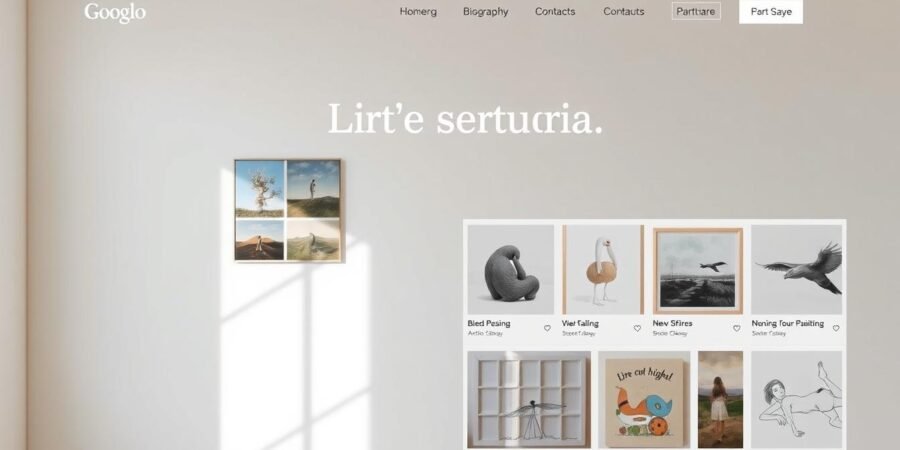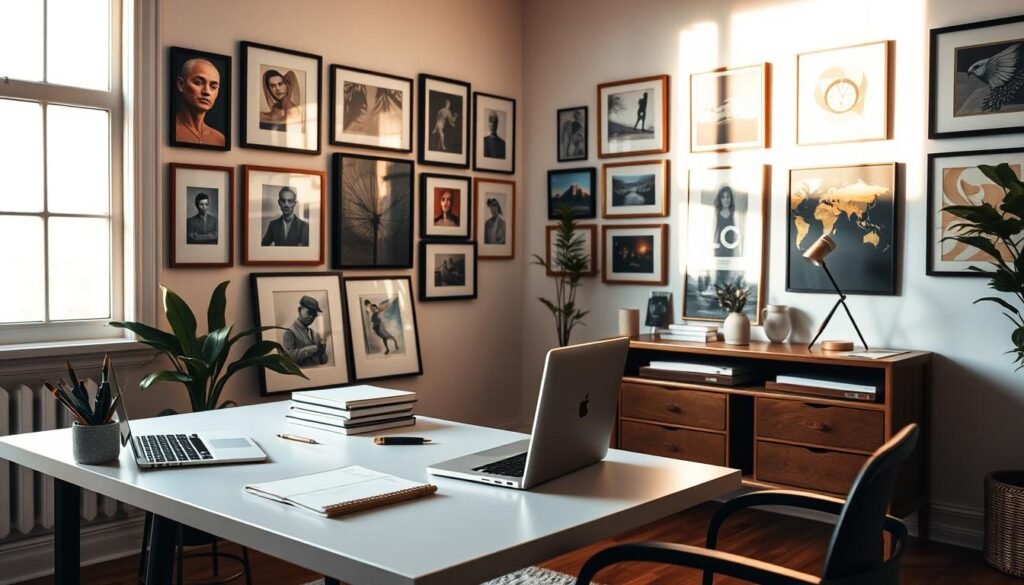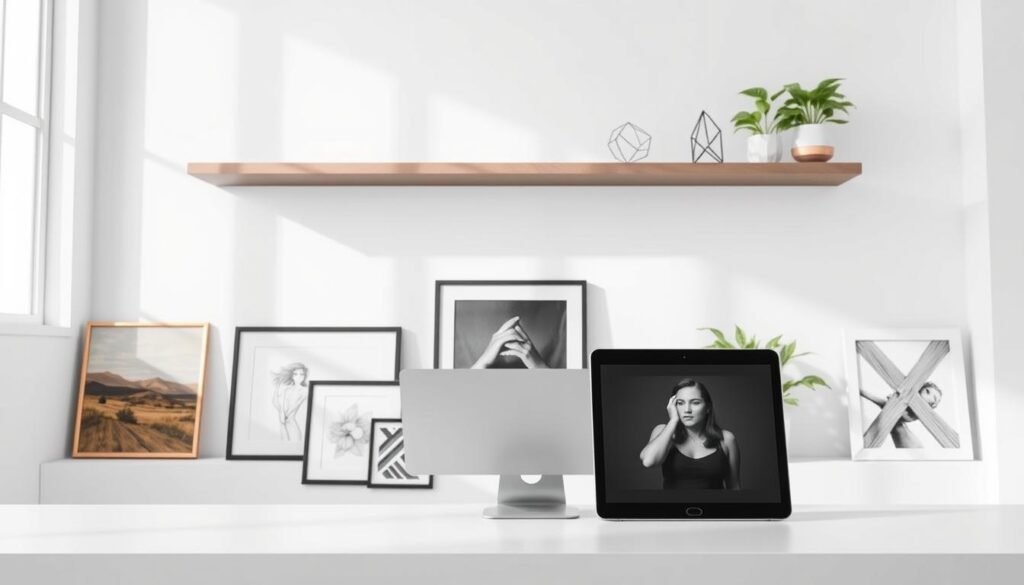In the competitive art world, having a professional online art portfolio is key. It acts as a visual resume, showing off an artist’s skills, style, and experience.
Learning how to create an online art portfolio can seem tough. But with the right help, artists can show off their work well and reach their audience.
A good online portfolio does more than just show your work. It also makes it easy for people to enjoy your art. This makes it simpler for potential buyers to find and appreciate your work.
Key Takeaways
- Understand the importance of having a professional online presence.
- Learn tips for creating an effective online art portfolio.
- Discover how to showcase your art to attract collectors and clients.
- Gain insights into optimizing your portfolio for better visibility.
- Explore strategies for engaging your target audience.
Understanding the Purpose of Your Art Portfolio
Knowing why you have an art portfolio is crucial. It’s not just a collection of your work. It’s a tool to show off your skills, style, and vision.
Defining Your Goals and Target Audience
To make a great art portfolio, you need to know your goals and who you want to reach. This means figuring out if you want to sell art or get commissions.
Selling Art vs. Attracting Commissions
Selling art means showing off finished pieces to buyers. Getting commissions is about showing you can do custom work. Your portfolio should match your main goal.
Identifying Your Ideal Collector or Client
Knowing who you want to attract helps you tailor your portfolio. Think about what they like, the art they’re interested in, and if your work fits their taste.
Different Types of Art Portfolios and Their Functions
There are many types of art portfolios, each with its own purpose. Some focus on one style or medium, while others are more varied. Knowing the types helps you choose the right one for you.
Identifying What Makes Your Art Unique
Your portfolio should show what makes your art special. This could be a unique style, technique, or theme that makes you stand out.
Developing Your Artistic Voice
Developing your artistic voice is key to a strong portfolio. It means refining your style and making sure your work is consistent in quality and theme.
Essential Elements of a Successful Art Portfolio
A successful art portfolio is more than just a collection of artworks. It’s a story that shows an artist’s unique vision and skill. When designing an art portfolio website, artists must focus on several key elements. These elements work together to captivate the audience and show the artist’s identity.
Quality Over Quantity: Curating Your Best Work
The first step in creating a digital art showcase is to pick your best work. This means carefully choosing only your strongest pieces to showcase.
Selection Criteria for Portfolio Pieces
When picking artworks for your portfolio, consider these criteria:
- Relevance to your artistic theme or style
- Technical skill and craftsmanship
- Originality and creativity
- Emotional or intellectual impact on the viewer
Cohesive Presentation and Visual Storytelling
A cohesive presentation is key for a successful art portfolio. It’s about creating a visual story that ties your artworks together. This makes it easy for viewers to follow your artistic journey.
“The portfolio is a reflection of the artist’s vision and should be treated as a dynamic entity that evolves with the artist’s career.”
, says a renowned art curator. This shows how important it is to keep updating and refining your portfolio.
Artist Statement and Bio That Connects
An effective artist statement and bio are crucial. They give context to your work and help viewers understand your artistic vision and background.
Examples of Effective Artist Statements
A good artist statement is short, clear, and engaging. For example:
- “My work explores the intersection of nature and technology, using mixed media to create immersive experiences.”
- “Through my art, I aim to capture the essence of urban landscapes, highlighting the beauty in the mundane.”
By including these essential elements, artists can make a successful art portfolio. This portfolio effectively showcases their work and attracts their target audience.
How to Create an Online Art Portfolio Step by Step
In today’s world, an online art portfolio is essential for artists. It lets them show their work to people all over the world. This is more than just a luxury; it’s a must for attracting collectors and clients.
Choosing the Right Platform for Your Needs
Finding the right platform for your online art portfolio is key. It depends on what you need, your technical skills, and your budget.
Dedicated Portfolio Websites vs. Self-Hosted Options
Dedicated portfolio websites are easy to use and come with many templates for artists. Self-hosted options give you more control over how your site looks and works.
Cost Comparison and Features
| Platform | Cost | Features |
|---|---|---|
| Dedicated Portfolio Websites | $10-$30/month | Templates, Customer Support, E-commerce Integration |
| Self-Hosted Options | $5-$20/month (hosting) + Design/Development Costs | Full Customization, Control Over Data |
Setting Up Your Portfolio Website
After picking your platform, setting up your site is next. You’ll choose a template, upload your art, and arrange how people navigate your site.
Organizing Your Work into Meaningful Categories
Organizing your art into categories makes it easier for visitors to find what they’re looking for. You can group by medium, theme, or project.
By following these steps, you can make a great online art portfolio. It will help you show your work to collectors and clients.
Photographing and Presenting Your Artwork Professionally
When showing art online, the quality of your images is key. A good digital image of your art can draw in collectors and clients.
Equipment and Techniques for High-Quality Art Photography
To take professional photos of your art, you need the right tools and skills. A good camera and knowing how to use light can make a big difference.
Editing Images for Optimal Online Display
After taking your photos, editing is important for online viewing. Adjusting brightness, contrast, and color balance makes your art look its best online.
File Formats and Resolution Guidelines
For online viewing, use JPEG format with 72 dpi resolution. But for printing or keeping, a higher resolution is better.
Context and Presentation: Showing Scale and Details
Showing your art in context can make it more appealing. Images that show size and details help buyers understand your art better.
| Art Medium | Recommended Lighting | Editing Tips |
|---|---|---|
| Paintings | Softbox or diffused natural light | Adjust color balance and contrast |
| Sculptures | Raking or directional light | Enhance texture and shading |
| Photography | Soft, even lighting | Adjust exposure and color grading |
By taking and presenting your art professionally online, you can draw in art lovers and collectors.
Designing a User-Friendly Portfolio Website
A successful art career starts with a great portfolio website. It should look good and be easy to use. A well-made site shows off your art and makes visitors want to see more.
Navigation and User Experience Best Practices
For a user-friendly portfolio, make navigation simple. Use clear menus and organize your art well. Make sure visitors can find info about you and your work easily.
- Use clear and concise menu labels
- Organize artwork into relevant categories
- Include a search function for larger portfolios
Mobile Responsiveness and Loading Speed
Many people visit websites on their phones. So, making your site mobile responsive is key. Also, make sure your site loads fast. Slow sites can scare off visitors.
Testing Your Portfolio Across Devices
Check your portfolio on different devices often. Look for layout problems, slow images, and any other issues. This ensures a smooth experience for everyone.
Color Schemes and Typography That Complement Your Art
Your website’s design should match your art. Pick a color scheme that brings out your art without taking over. Choose typography that’s easy to read and fits your style.
By paying attention to these details, artists can make a website that showcases their work well. It will attract collectors and clients too.
Writing Compelling Content for Your Art Portfolio
Your art portfolio’s content is key to connecting with buyers and art lovers. Compelling content makes your portfolio stand out and leaves a lasting impression.
Crafting an Engaging Artist Statement
An artist statement is crucial for your portfolio. It should clearly show your artistic vision and what inspires you. When building an art portfolio online, your artist statement is often the first thing visitors see.
To make a great artist statement, focus on what makes you unique and your creative themes. Keep it short and true to your artistic identity.
Creating Artwork Descriptions That Resonate
Artwork descriptions add depth and context to your art. They should connect with your audience on an emotional level. When writing descriptions, mix technical details with the emotional and conceptual sides of your work.
Balancing Technical Details with Emotional Connection
A good artwork description tells a story, not just lists facts. You might talk about your inspiration, the creative process, or the meaning behind certain parts of the piece.
| Element | Description | Example |
|---|---|---|
| Technical Details | Include medium, size, and techniques used. | Oil on canvas, 24×36 inches, using layering techniques. |
| Emotional Connection | Share the story or inspiration behind the artwork. | “This piece reflects my journey through nature, capturing the serenity I find in landscapes.” |
About Page: Telling Your Story Authentically
Your About page is where you share your story and connect with your audience. It should be real and show your journey as an artist. When creating an online portfolio, this page is a chance to connect deeply with potential collectors and fans.
By focusing on these elements, you can make a compelling art portfolio. It showcases your work and tells your story. This will attract the right audience and build a lasting connection with them.
SEO Strategies for Art Portfolios
In today’s art market, having a well-optimized online portfolio is crucial. It helps artists reach out to buyers and galleries. To draw in collectors and clients, artists need to follow SEO best practices.
Keywords and Metadata for Artists
Choosing the right keywords and metadata is vital for your portfolio’s search engine visibility. Find terms that people might search for when looking for art like yours. Use these keywords in your page titles, descriptions, and headings.
Image Optimization for Search Engines
Since art portfolios rely heavily on visuals, image optimization is key. Make sure your images are high-quality but also web-friendly. Use descriptive file names and alt tags with your target keywords.
Building Backlinks to Your Portfolio
Getting backlinks from trusted sites can greatly improve your portfolio’s SEO. A good way to do this is through collaborations and guest features.
Collaborations and Guest Features
Working with other artists, galleries, or art bloggers can open doors for guest features. This not only grows your audience but also brings valuable backlinks to your portfolio.
By using these SEO strategies, artists can boost their online presence. This makes it simpler for potential collectors and clients to find their work.
Incorporating Contact and Sales Information Effectively
To turn visitors into buyers, artists need to add contact and sales info to their online portfolios. This makes it easier for people to buy art or get a custom piece. It also makes the buying process smoother.
Clear Call-to-Action for Potential Clients
A clear call-to-action (CTA) is key to guiding potential buyers. Use prominent buttons or links to direct visitors to contact you or see your work. For example, “Inquire About This Piece” or “Commission a Custom Artwork” works well.
Pricing and Purchasing Options
Artists have to think about pricing and buying options. Showing prices can help weed out uninterested buyers. But it might scare off some potential clients. Here are some things to keep in mind:
- Transparency: Being clear about prices can build trust with buyers.
- Flexibility: Offering different prices or custom options can attract more clients.
- Negotiation: Allowing for negotiation can be good for high-end or custom art.
To Display Prices or Not: Pros and Cons
Showing prices can save time for both the artist and buyers. But it might limit price negotiations. Not showing prices lets for more negotiation but might scare off serious buyers who want clear prices.
Commission Process and Policies
For artists who take commissions, having a clear process and policies is key. This includes:
- Outlining the steps for commissioning a piece.
- Specifying payment terms and any deposits needed.
- Detailing how you’ll communicate and the expected timelines.
By adding these elements, artists can make an online gallery that draws in and keeps potential buyers. This can lead to more sales and commissions.
Promoting Your Online Art Portfolio
Promoting your online art portfolio is key to attracting collectors and clients today. With so many artists online, a good strategy can stand out.
Social Media Strategies for Artists
Social media is a must for artists to promote their work. Each platform has its own way to engage and expose your art.
Platform-Specific Approaches
Instagram is great for artists because it’s all about visuals. You can share your work with high-quality images and stories. Pinterest helps artists reach people looking for inspiration. And TikTok is perfect for sharing your creative process and behind-the-scenes moments, attracting a younger crowd.
Email Marketing and Newsletters
Email marketing is still a strong tool for artists to connect with collectors and buyers. Newsletters can share new work, upcoming shows, and personal stories, keeping your audience interested.
Building and Nurturing Your Collector List
Building a collector list takes effort. You need to encourage sign-ups on your website and social media. It’s important to send regular, valuable content to keep them interested.
Networking with Galleries and Art Communities
Networking with galleries and art communities can really help your portfolio. Join local art events, online forums, and collaborate with other artists for new opportunities.
Leveraging Art Marketplaces as Portfolio Extensions
Art marketplaces like Saatchi Art, ArtNet, and Etsy can expand your portfolio. They help you sell your work and reach more people.
| Platform | Primary Use | Benefit for Artists |
|---|---|---|
| Visual Storytelling | High engagement through images and stories | |
| Inspiration and Ideas | Reaching audiences looking for art | |
| TikTok | Dynamic Content | Engaging younger audiences with creative process videos |
Art marketing expert
“The key to a successful online art portfolio is not just showcasing your art, but also telling your story and connecting with your audience on multiple platforms.”
This shows the importance of using many ways to promote your online art portfolio.
Conclusion: Maintaining and Evolving Your Art Portfolio
Creating a professional art portfolio is just the beginning. It’s important to keep it updated and fresh. As artists grow, their portfolios should show new skills and styles. Regular updates keep the portfolio appealing to collectors and clients.
Building an online art portfolio takes ongoing effort. It means adding new content and keeping up with the art market. By regularly updating and curating their work, artists can show their latest artistic direction.
To get more visibility, artists should optimize their portfolio for search engines. They should also engage with their audience through different channels. This way, their art can reach more people, making their portfolio a powerful tool for new opportunities.





Leave a Reply